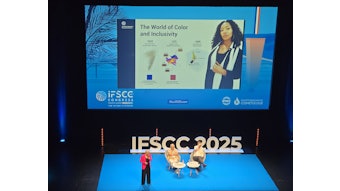Those who work in the perfumery industry know that much can go wrong in the world of scent. For example, raw materials can vary in their aroma quality, oxidation can change a material’s aroma profile as it sits on a shelf waiting to be purchased and packaging can interact with components in products, altering aroma quality. In addition, a variety of undesirable odors can creep into products during the production and distribution process, and off-odor is a common problem for a variety of consumer goods. In turn, negative olfactory and consumption-changing experiences are common.
When an odor problem occurs and the consumer complaints come in, the usual first step is for the product manager to order some kind of analysis to quickly identify the odor. The analysis typically chosen is gas chromatography coupled with mass spectrometry (GC/MS), and this technique is ideal for the identification of chemical compounds in a product. Trace level compounds can be isolated by the GC part and identified by MS. However, the GC/MS process cannot “smell” the sample, nor can the much-touted electronic nose technique.
With these analyses, there is no correlation of the detected compounds with their respective odors, and there may be hundreds detected. What this means is that although you can identify the compounds, you do not know which one is causing the offending odor. A lab may work months on the problem using these techniques, but the chances of correctly identifying the odor are slim. The reason for the lack of success is that those techniques alone cannot make the correlation between odor and chemical identification. Only the human nose connected to a normally functioning brain can distinguish among all the chemical compounds in a sample as to odor character and intensity.
To “see” the odor among the aromas, specialized equipment must be utilized in conjunction with the human sense of smell. The general technique is called “sensory-directed odor analysis.” The process works by first collecting a sample and then completely separating each chemical compound from all the others. The collection process varies depending on the product being evaluated. These separated compounds may or may not have an aroma. When each individual compound exits from the instrument, it is sniffed by a human analyst, who describes its aroma character. At the same time, the analyst uses personal sensitivity to the aroma compound to give a subjective intensity for it in the sample under investigation. The final result of sniffing through a sample is an aromagram. This graph shows all volatile aroma compounds in the order in which they exit the instrument. Their intensity is shown by the size of the peak, and there is the associated aroma character with each peak. The aromagram ranks the importance of the aromas in terms of their intensities and, often more importantly, in terms of their character. Off-odors are quickly distinguished in the aromagram, and if they are intense, they are most likely contributors to the odor problem.
In addition to detection of aromas by the human nose, systems that use a mass spectrometer to simultaneously obtain the identity of the aroma along with its character and intensity are available, permitting fast resolution of odor problems that otherwise might take months, or might never be completed, using less sophisticated and integrated analytical systems.
Sniffing Out the Clues
Some of the most offensive odors that can occur in cosmetic products have sulfur in their molecular formula. Several projects have come to Microanalytics in which consumers have complained to the manufacturer of an unpleasant sulfur-based odor; a particularly notable project involved a skin cleanser that generated numerous complaints because of its “garlic” odor. The “garlic” descriptor indicates sulfur to a sensory analyst. When the sample was run and compared with a retained skin cleanser that did not have any trace of “garlic,” it was immediately clear that a single, intense off-odor corresponded exactly to the unpleasant odor. The instrument identified it as a sulfur compound, and showed that it was present at a very low concentration even though it gave a strong odor response to the whole product.
There were numerous aromas in the product, but the use of the sensory-directed odor technique quickly placed the focus on the bad odor. The odor was then traced to a raw material, and, because the identity of the off-odor was known, it was then possible to screen raw materials for the off-odor compound using conventional quality control techniques.
Development and QA
Sensory-directed odor analysis is a useful tool to resolve crisis-driven product quality problems. In some cases, the future customer acceptance of a product is at stake unless the odor can be removed quickly before the public has time to form a permanent negative impression. Another scenario for this type of analysis is its use in conjunction with the development of a new product.
When sunless tanning cream was being developed, it was noted that odors were generated under certain conditions. In one promising product under development, the odor was found strong enough to negatively impact consumer acceptance. The complex odor of the applied cream changed with time, and was hard to characterize except that it had a lot of food-like aromas—though none you’d want to eat.
Before the sample can be run, it first has to be collected, and this process combines both a low- and high-tech approach. In the sunless tanning cream example, the analyst applied the product to his own leg, and the site was wrapped in aluminum foil to contain the odor. A very small probe was inserted via a pin hole in the aluminum. The fibers within the probe collected the vapors, which were then transported to the analysis unit. A very small amount of fiber—less than 1 cubic millimeter—is all that was needed to collect the vapor sample. The fibers are then heated to 250°C, which releases the compounds individually and allows them to be measured and identified.
When the sensory-directed odor analysis was carried out, aromas described as buttery, meaty, sour and floral were found to be quite intense—with more than 30 food-like aromas present. This result showed that the formulation was generating many more chemicals than desired—especially odor compounds. Changes in formulation were made, and the follow-up analyses provided comparisons that pointed in the direction of a higher quality product.
The aroma quality of a product is just one of the many critical properties that must be carefully controlled to ensure customer acceptance, and with recent technological inroads, accurate aroma quality control is now within every manufacturer and brand owner’s reach.










